Get your family excited about astronomy with these seven stellar activities: host a backyard constellation hunt, create DIY star wheels, organize meteor shower watch parties, build cardboard telescopes, start moon phase journals, play astronomy card games, and plan dark sky park adventures. You’ll need simple items like blankets, star charts, and red flashlights to transform ordinary evenings into cosmic explorations. These engaging stargazing experiences offer perfect opportunities to bond while sparking curiosity about our vast universe.
Host a Backyard Constellation Hunt
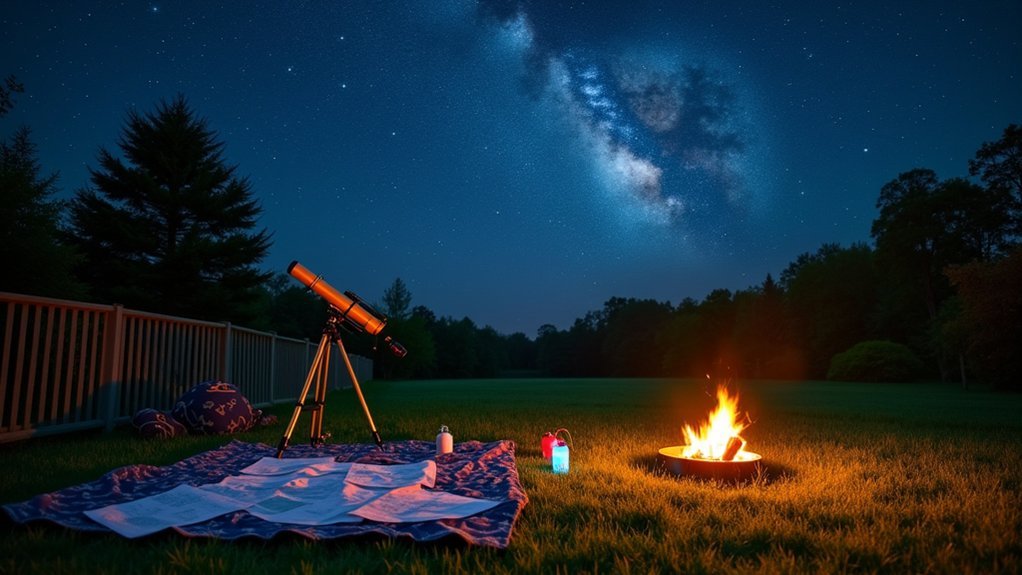
While the night sky holds countless wonders, you don’t need to be an astronomer to enjoy them with your family. A backyard constellation hunt transforms your yard into an astronomical playground that’s exciting for all ages.
Create a list of beginner-friendly constellations like Orion and Ursa Major, then use a stargazing app or star chart as interactive technology to help everyone locate these celestial patterns.
Start with the night’s most recognizable stellar formations—they’re like cosmic connect-the-dots for beginners of all ages.
Set up a comfortable viewing area with blankets and pillows where family members can relax while searching the heavens.
Encourage creativity by inviting participants to invent their own constellations and stories. Implement a simple reward system with stickers or small prizes for those who identify constellations successfully.
This family-friendly stargazing activity combines learning with imagination, making astronomy accessible and memorable for children and adults alike.
Create a DIY Star Wheel for Young Astronomers
You’ll transform your family’s stargazing experience with a simple DIY star wheel that helps identify constellations based on date and location.
This hands-on craft requires just two circular pieces of cardboard—with the top one cut out to reveal the star patterns below—that rotate to display different celestial objects visible throughout the year.
Simple Star Navigation Tool
Because stargazing becomes even more exciting when you understand what you’re looking at, a DIY star wheel makes a perfect educational project for young astronomers. This hands-on activity helps kids identify constellations based on the date and time of their night sky adventures.
To create your star wheel, you’ll need two pieces of cardstock: one circular base showing the constellations and a rotating top piece with viewing windows. Customize it to show seasonal stars visible from your location.
| Materials | Assembly Steps | Usage Tips |
|---|---|---|
| Cardstock | Cut circular base | Align date with time |
| Scissors | Create viewing window | Point toward north |
| Brass fastener | Attach layers together | Use red flashlight |
This educational tool transforms casual stargazing into an engaging astronomy lesson, encouraging curiosity about the cosmos while developing practical navigation skills.
Educational Celestial Craft
Three educational benefits make star wheels particularly valuable for young astronomers. First, they enhance understanding of celestial movements, illustrating how constellations shift throughout the year.
Second, they transform abstract astronomical concepts into tangible learning experiences.
Third, they empower kids to identify stars independently during nighttime adventures.
Creating this educational craft requires just cardboard, a printed star chart, and a rotating disk that aligns with current dates.
When stargazing with kids, your homemade DIY star chart becomes an interactive guide that helps them locate specific constellations in the night sky.
Many astronomy clubs recommend star wheels because they engage your kids more effectively than passive observation.
This hands-on approach cultivates curiosity about the universe while providing a practical tool they’ve created themselves.
Hands-on Constellation Learning
Building your own star wheel transforms stargazing from passive observation to active exploration. With just two pieces of sturdy paper, a brass fastener, and a printed star map, you’ll create a practical tool that helps identify constellations based on date, time, and location.
Customize your DIY star wheel to showcase local celestial objects, making it relevant to your specific night sky. As you construct this tool together, you’ll have perfect opportunities to share the fascinating mythology behind the constellations your children will soon discover.
During stargazing sessions, the star wheel becomes an interactive experience that engages children in actively locating and identifying stars. This hands-on approach not only fosters creativity but also deepens their understanding of celestial movements while making family astronomy nights more meaningful and educational.
Set Up a Family Meteor Shower Watch Party
You’ll create unforgettable “Meteor Magic Moments” by planning your family watch party during peak showers like the Geminids in December 2025, when excellent visibility combines with impressive meteor counts.
Don’t forget your “Shower Comfort Essentials” including recliners or thick blankets for neck support, warm clothing layers, and thermoses of hot chocolate to keep everyone cozy during hours of skygazing.
Enhance your experience with stargazing apps that help identify meteor origins while transforming the night into both an educational adventure and precious family bonding time.
Meteor Magic Moments
While stargazing offers year-round enjoyment, nothing quite matches the thrill of watching meteors streak across the night sky with your loved ones. The Geminid meteor shower in December 2025 presents a perfect opportunity for a family stargazing trip under dark skies.
Create a cozy atmosphere with blankets and warm drinks as you witness this celestial spectacle together.
Make your meteor shower experience meaningful by:
- Finding locations away from city lights to maximize your chances of spotting shooting stars
- Using a stargazing app to identify constellations visible in the night sky
- Encouraging children to make wishes upon seeing meteors, fostering wonder about our universe
- Transforming the event into an educational experience that creates lasting memories
Shower Comfort Essentials
To fully enjoy the celestial spectacle of a meteor shower, comfort becomes just as important as finding the ideal dark-sky location. Set up your family watch party with lightweight, portable chairs like CLIQ models that offer easy setup while keeping everyone relaxed during hours of skyward gazing.
| Comfort Category | Essential Items | Benefits |
|---|---|---|
| Seating | Portable chairs | Easy transport, comfortable viewing |
| Warmth | Blankets, layers | Keeps cozy during cool nights |
| Refreshments | Snacks and drinks | Maintains energy, adds fun |
| Navigation | Star charts, apps | Helps young stargazers identify events |
Don’t forget to scout locations with minimal light pollution for best viewing conditions. While your family waits for shooting stars, use astronomy apps to identify constellations, making the stargazing experience both educational and magical for children under clear skies.
Build a Simple Cardboard Telescope Together
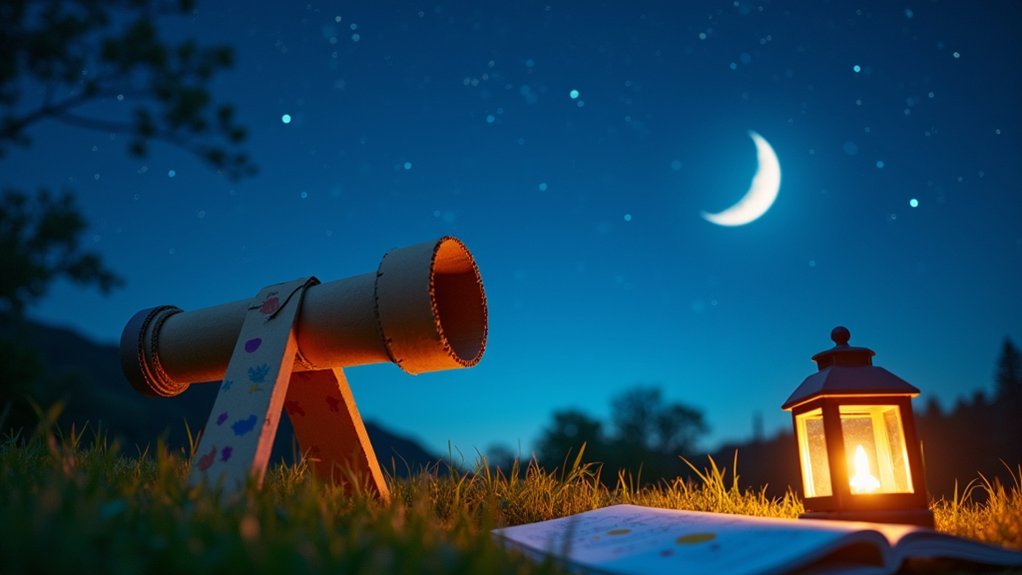
Building a simple cardboard telescope together creates an exciting opportunity for families to explore the wonders of optics while preparing for nighttime stargazing.
This fun activity helps you identify stars and constellations in the night skies with your own handmade viewing tool.
Materials like cardboard tubes, magnifying lenses, and tape transform into a science lesson that children can actively participate in.
Here’s why this project makes for memorable exploration:
- Children learn fundamental optics principles through hands-on construction
- The telescope becomes a personal tool to explore the night sky
- The building process itself creates lasting memories through shared discovery
- Documentation of celestial observations enhances scientific thinking
Take your creation outdoors during your next stargazing session and watch as your children’s eyes light up with wonder.
Start a Family Moon Phase Journal
Recording the moon’s changing face can become an enchanting family ritual that connects children to the rhythms of our nearest celestial neighbor.
Create a journal where kids can document each night’s lunar appearance, including date, time, and weather forecast. Encourage them to sketch what they see or take photos under dark skies.
For each entry, discuss what makes that particular phase special—like how the New Moon creates perfect conditions for spotting faint stars on your star maps.
Use a tennis ball and flashlight to demonstrate how phases occur, making abstract concepts tangible.
As your family tracks the moon’s journey, share stories about the stars and cultural moon myths.
This simple practice inspires kids to explore patterns in the night sky while creating meaningful stargazing activities you’ll treasure for years.
Play Astronomy-Themed Card Games Under the Stars
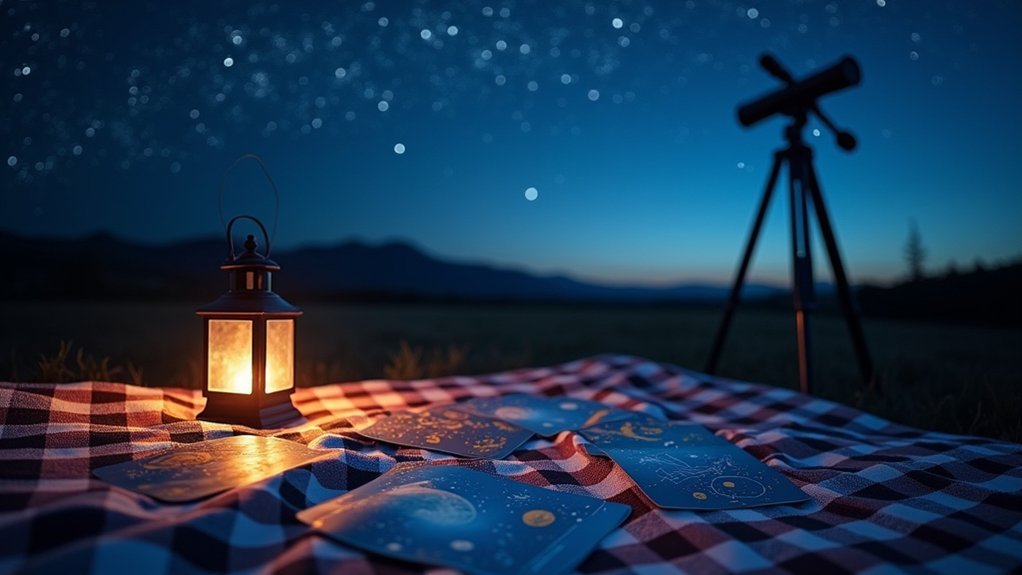
While gazing at the night sky, your family can transform stargazing into an engaging game night with astronomy-themed card games like Star Deck. These fun, educational activities cost nothing—download them for free and bring your stargazing adventure to life while learning about constellations.
Playing astronomy-themed card games offers families:
- A hands-on way to identify stars and constellations you’re actually observing overhead.
- Natural conversation starters about celestial objects that spark curiosity about space.
- Family fun that works for all ages and skill levels, regardless of astronomy knowledge.
- Meaningful bonding time that combines entertainment with education under the stars.
These games seamlessly integrate with your night sky observations, turning what kids might see as “just looking up” into an interactive activity they’ll enthusiastically anticipate.
Plan a Dark Sky Park Overnight Adventure
For families seeking an unforgettable astronomical experience, a trip to a designated dark sky park offers the ultimate canvas for stargazing adventures. Cherry Springs State Park in Pennsylvania is perfect for stargazing with virtually no light pollution. Schedule your visit during a new moon and pack essentials like binoculars or a telescope to spot celestial objects.
| Activity | Benefit |
|---|---|
| Use stargazing apps | Identifies constellations and planets (which don’t twinkle!) |
| Organize a stargazing scavenger hunt | Make a game that keeps kids engaged |
| Pack red flashlights | Preserves night vision while maneuvering |
| Keep a sky journal | Records memorable sightings and experiences |
Don’t forget warm clothes and comfortable seating! Create lasting memories by telling stories about constellations while wrapped in blankets under the spectacular cosmic display.
Frequently Asked Questions
What Do We See in the Sky at Night for Kids?
You’ll see stars forming constellations like Orion, bright planets including Venus and Jupiter, the Moon’s changing phases, exciting meteor showers, and even the Milky Way in dark locations.
How Do Stars Shine at Night for Kids?
Stars shine because they’re giant balls of gas where hydrogen turns into helium, creating light. You’re seeing their glow from far away, and they twinkle when their light bounces through Earth’s atmosphere.
What Is Star Gazing for Kids?
Stargazing for kids is when you look up at the night sky to discover stars and planets. You’ll learn about constellations, hear mythical stories, and develop curiosity about our universe while having fun outdoors.
What Are Stars Kid Friendly?
Stars are huge balls of hot, glowing gas that twinkle in our night sky. You’ll notice they come in different colors and sizes. They’re like distant suns, millions of miles away from Earth.
In Summary
You’ve now got a stellar toolkit for exploring the night sky with your family! Whether you’re mapping constellations, crafting astronomy tools, or camping under meteor showers, you’re creating memories that’ll sparkle as brightly as the stars themselves. Don’t wait for the perfect moment—the universe is putting on a show tonight. Grab your blankets, head outside, and let the cosmic wonder begin!

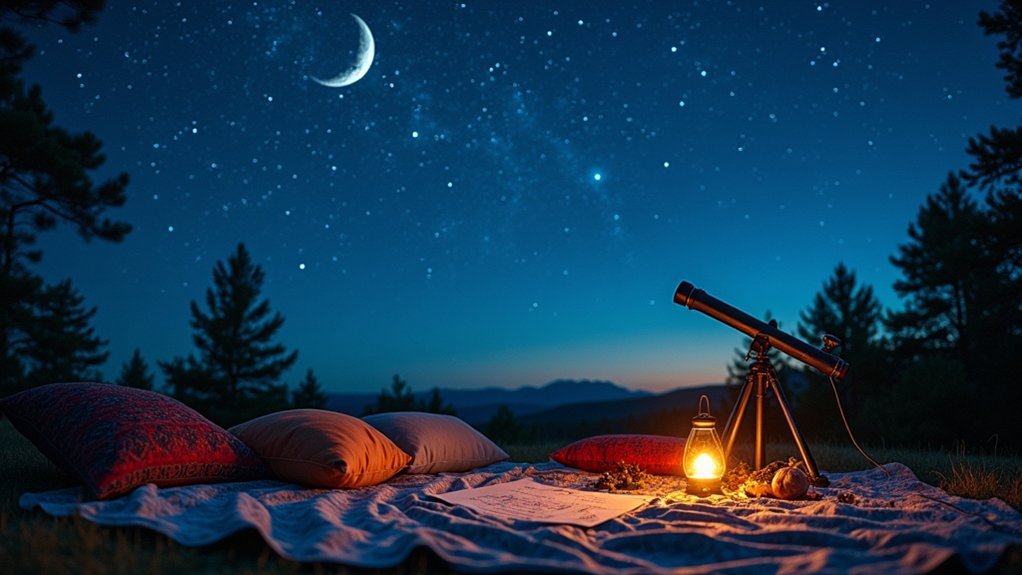
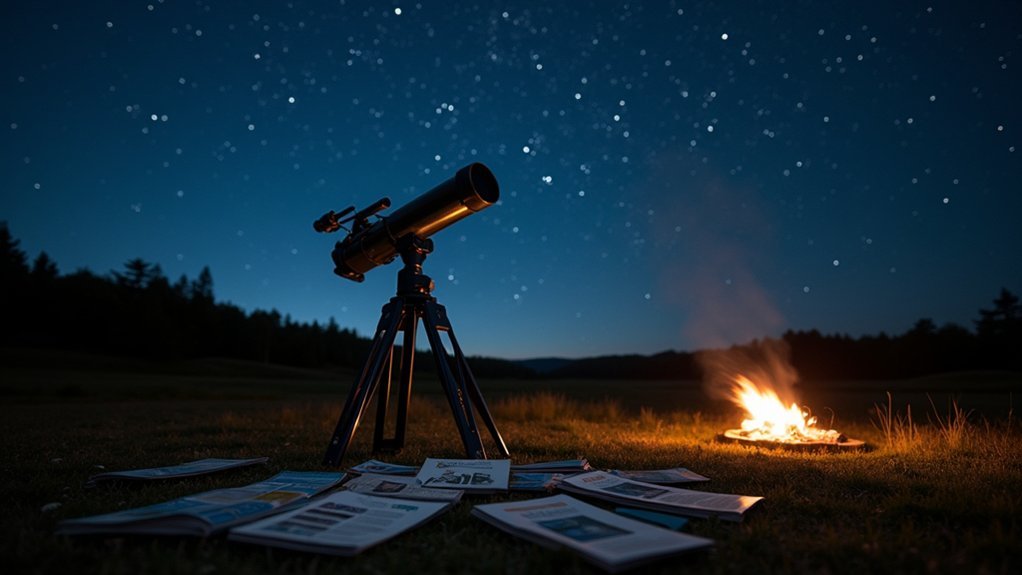
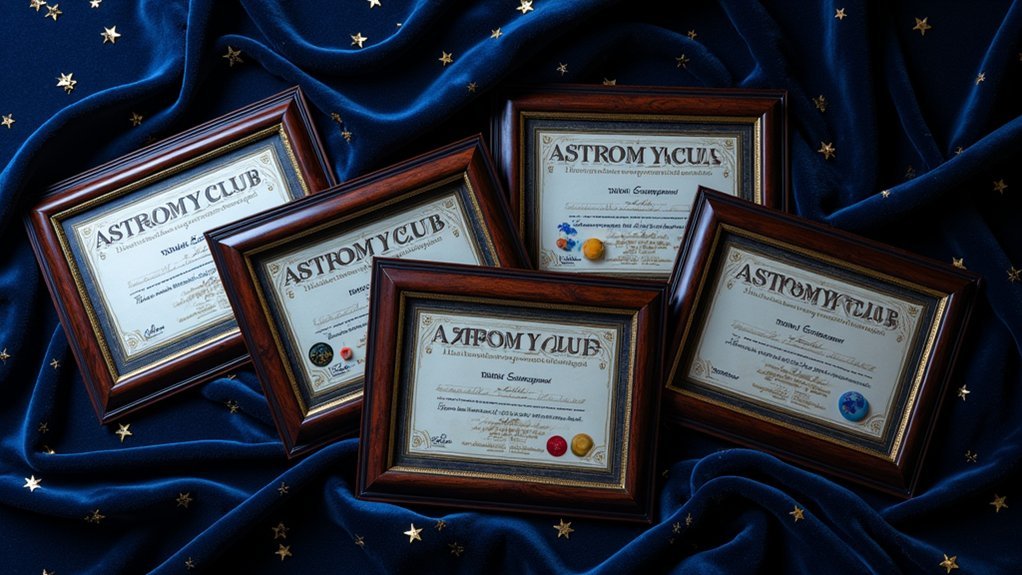
Leave a Reply